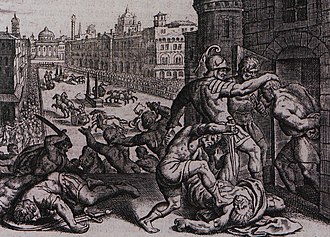
Back Masacre de Tesalónica AST Солунско клане Bulgarian Massaker von Thessaloniki German Masacre de Tesalónica Spanish کشتار تسالونیکی Persian Massacre de Thessalonique French Pembantaian Tesalonika ID テッサロニカの虐殺 Japanese Bloedbad van Thessaloniki Dutch Massacre de Tessalônica Portuguese

The Massacre of Thessalonica in Macedonia, Greece was a massacre of local civilians by Roman troops which is believed to have occurred around 390. According to Sozomen, in June of that year Butheric, a Roman general stationed in Thessalonica as a magister militum was lynched in an urban riot by an angry mob in the circus after having a famous circus charioteer arrested for pederasty, and refusing the people's demand for his release, although, this is found in only one source. In response, Theodosius authorized his Gothic soldiers to punish the people of the city resulting in the killing of a large number of citizens when they were assembled in the city's hippodrome.
Modern historians have had difficulty discerning the details of the massacre and its aftermath, as there are no contemporaneous accounts of the event. Instead, the works of fifth-century church historians provide the earliest record of what happened. Many parts of these accounts contradict one another, and some are of questionable reliability. The pagan historians of late antiquity do not discuss the massacre at all. Scholars contend that most extant records portray events by focusing on the moral perspective rather than the historical and political details. This makes it difficult for modern historians to distinguish fact from legend. Nonetheless, most classicists accept at least the basic account of the massacre, although they continue to dispute when it happened, who was responsible for it, what motivated it, and what impact it had on subsequent events.
Most scholars agree that Emperor Theodosius the Great played at least some role in either ordering or permitting the massacre, although others contend that the soldiers simply got out of control. Historically, Theodosius took responsibility upon himself, and that is when Ambrose (339–397 AD), bishop of Milan, became involved. Ambrose was absent from court when these events took place, and though he was one of Theodosius' many counselors, he was not one of the consistory (Theodosius' closest advisory council). Ambrose got much of his information on Theodosius through an informant, and, after he was informed of events concerning the events at Thessalonica, Ambrose wrote Theodosius a letter stating the emperor needed to demonstrate repentance for the massacre, further adding that emperor Theodosius would be forbidden from receiving the Eucharist until he had done so. History indicates Theodosius chose to cooperate with Ambrose' requirement.
© MMXXIII Rich X Search. We shall prevail. All rights reserved. Rich X Search